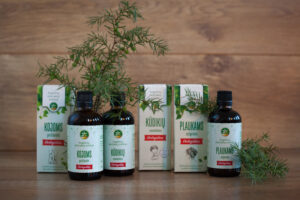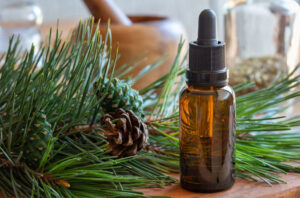This invasive wild herb was named after St John because it blooms on St John’s Day and is also referred to as St John’s blood (because crushed seeds and blossoms produce blood-like red juice). For its peculiar chemical composition, folklore refers to St John’s wort as the herb, which treats 99 diseases, while its universal application has led Germans to calling it the inner sun.
St John’s wort contains colouring agents, flavonoids: hyperine (1.6-2.6 % in leaves and 2.2 % in blossoms), rutin (1.7-2.8 % in leaves and 1.2 % in blossoms), hypericin, pseudohypericin, quercitrin, chlorogenic and caffeic acid, also essential oil, which includes terpenes, sesquiterpenes and isovaleric acid esters, fermenting substances (12-15 % in leaves and 15-17 % in blossoms), up to 55 mg% carotene, organic acids and minerals.
It is widely believed that St John’s wort can be used only for treating ailments of the nervous system. However, in truth, St John’s wort also helps to get rid of anxiety, regain spiritual balance and improves mood. Its active substances hypericine and hyperforin restore energy flows in the brain, creating a soothing effect, which helps to regain strength. St John’s wort infused oil — phytol — can be used as a cosmetic product.
Medicine uses only the top 25-30 cm of the shrub with its leaves and blossoms. St John’s wort must be harvested during blooming, leaving a single stem. Left in a bunch it quickly heats up and turns black, thus must be instantly dried in a dryer or a ventilated shed. The temperature in a heated dryer cannot exceed 40 C. 100 kg of fresh material produces 22-23kg of dried herbs. Dried herbs are gently flailed, being careful not to crush the stems.
Dried material is characterised by a scent of balsam and a slightly bitter flavour. It may contain no more than 13 % moist, at least 25 % of extracts, no more than 8 % of ash after burning, no more than 1 % of ash, soluble in 1 % hydrochloric acid, no more than 10 % of crushed particles, falling out of a 2 mm sieve, no more than 1 % of organic additives and no more than 1 % of mineral additives.
St John’s wort tea can be used as a disinfectant, relieving inflammations, St John’s wort oil (picked petals soaked in oil for 2-3 weeks, occasionally stirring) is used for hard-to-heal wounds, stomatitis.
St John’s wort tea also used to be used for treating stomach, intestine and liver diseases.
This herb is not recommended for people suffering from constipation or high blood pressure.
Literature
Butkus, V., et. al. Mažieji miško turtai. Vilnius: Mokslas 1987.
Čekauskaitė, L. Gamtos vaistinėlė. Kaunas: Spindulys, 2003.
Kaunienė, V.; Kaunas, E. Vaistingieji augalai. Žinynas. Kaunas: Varpas, 1991.
Obelevičius, K; Petkevičiūtė, S; E. Šeinauskienė, E. Prieskoninių augalų ir jų vartojimo žinynas. Kaunas: Lututė, 2011.
Ragažinskienė, O.; Rimkienė, S.; Sasnauskas, V. Vaistinių augalų enciklopedija. Kaunas: Lututė, 2005.





